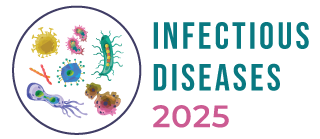Infectious Diseases 2025

Imam Mohammad Ibn Saud Islamic University, Saudi Arabia
Abstract:
Aims: Geospatial mapping techniques can be creatively utilized to consolidate and describe events sequentially, especially in instances of epidemics like COVID-19. Saudi Arabia was seriously affected by this epidemic across its 13 administrative areas, beginning in March 2020 and ending in May 2023. This research, utilizing mapping as a tool, explores the spread of disease over the period, illustrating its locational spread, geographic variations, prevalence, and burden.
Methods: This research utilized daily reports published by the Ministry of Health, Saudi Arabia. Analyses were carried out by dividing the infections into three periods 2000-2021; 2021-2022; and 2022-2023 for exploratory purposes. Analyzed data were then transferred to maps for visual presentations. They are presented in six panels of varying interpretations.
Results: During this period, 205 locations in the country were affected, with fewer cases in the first year, a wider spread in the second year, and subsidence in the third year. Although this pattern holds for infections, fatality continued beyond the period, as an aftereffect.
Conclusions: Severe prolonged infections and fatalities were observed in smaller administrative areas, especially in the southwestern regions, comprising Jazan, Najran, Aseer, and Al-Baha. Analyzing data using mapping is crucial for understanding the real picture of the rise and fall of COVID-19 infections, which is instrumental in planning and implementing precautions and control measures in similar epidemic and disaster situations.
Biography:
Hamad Mansour Aldossari is a scholar and researcher at the Department of Geography and Geographical Information Systems (GIS) at Imam Mohammad Ibn Saud Islamic University in Riyadh, Saudi Arabia. With a focus on geographic information systems and spatial analysis, Dr. Aldossari contributes to the development and application of GIS technologies in various geographical studies. His work emphasizes the integration of geospatial data for better decision-making and solutions in regional planning, environmental studies, and urban development.
